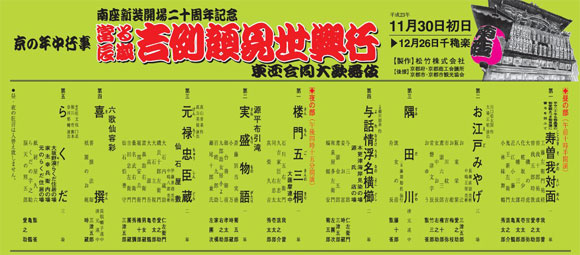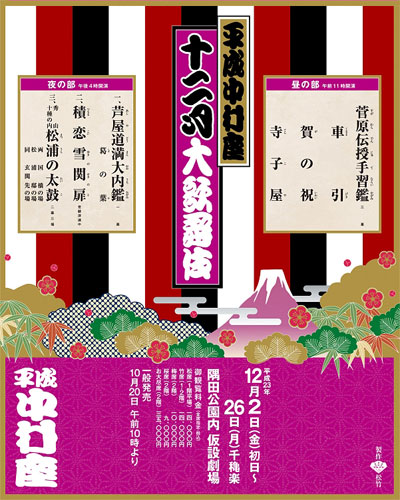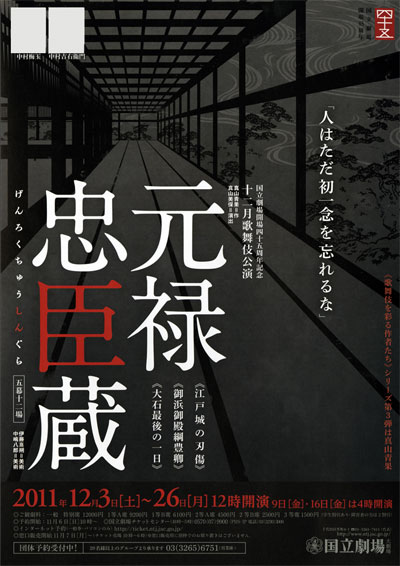| DECEMBER 2011 |
|
2 shows in Ky˘to (Minamiza), 5 in T˘ky˘ (Nissay Theatre, National Theatre, Heisei Nakamuraza), 1 in Kosaka (K˘rakukan) and 1 tour (Zenshinza)!
|
|
|||
| Dates | 30 November ~ 26 December 2011 (Kichirei Kaomise K˘gy˘) Annual Festive Face-Showing Performances |
||
| MatinÚe |
Yowa Nasake Ukina no Yokogushi (Kirare Yosa)
|
||
| Evening |
Genpei Nunobiki no Taki Genroku Chűshingura |
||
| Casting |
Sakata T˘jűr˘, Kataoka Nizaemon, Onoe Kikugor˘, Nakamura Tokiz˘, Band˘ Mitsugor˘, Nakamura Kanjaku, Kataoka Gat˘, Kataoka Hidetar˘, Kataoka Takatar˘, Kataoka Ainosuke, Ichikawa Danz˘, Ichikawa Sadanji, Ichikawa Omez˘, Kawarasaki Gonjűr˘, Band˘ Takesabur˘, Ichikawa Unosuke, Ichimura Kakitsu, Band˘ Shűch˘, Kamimura Kichiya, Nakamura Kikaku, Kataoka Shinnosuke, Nakamura Kazutar˘, Nakamura Baishi, Nakamura Mantar˘ |
||
| Comments |
This December kaomise performances celebrate the 20th anniversary of the refurbishment of the Minamiza.
|
||
 |
| Heisei Nakamuraza (T˘ky˘) | |
| Dates | 2 ~ 26 December 2011 (Jűnigatsu ďkabuki) December Grand Kabuki |
| MatinÚe |
|
| Evening |
Ashiya D˘man ďuchi Kagami (Kuzu-no-Ha) |
| Casting |
Nakamura Kanzabur˘, Nakamura Senjaku, Onoe Kikunosuke, , Band˘ Yajűr˘, Kataoka Kamez˘, Nakamura Kantar˘, Nakamura Shichinosuke, Onoe Matsuya, Band˘ Shingo, Nakamura Toranosuke |
| Comments |
The Heisei Nakamuraza is back in T˘ky˘ in the popular district of Asakusa. This time, it is a 7-month project (performances up to May 2012!) for this temporary theater built within the Sumida Park.
|
 |
| National Theatre (T˘ky˘) |
| Dates | 3 ~ 26 December 2011 |
| Program |
|
| Casting |
Nakamura Kichiemon, Nakamura Baigyoku, Nakamura Kaishun, Nakamura Shibajaku, Nakamura Kinnosuke, Nakamura T˘z˘, Nakamura Matagor˘, Nakamura Karoku, Nakamura Kash˘, Nakamura Utae, ďtani Keiz˘, Nakamura Matsue, Sawamura Yoshijir˘, Nakamura Tamatar˘, Nakamura Yonekichi, Nakamura Tanenosuke, Nakamura Takanosuke |
| Comments |
|
 |
|
|||
| Dates | 7 ~ 25 December 2011 (Jűnigatsu ďkabuki) December Grand Kabuki |
||
| MatinÚe |
Goban Tadanobu |
||
| Evening | |||
| Casting | |||
| Comments |
Ichikawa Ebiz˘, Ichikawa Somegor˘ and Onoe Sh˘roku, 3 great-grandsons of Matsumoto K˘shir˘ VII, celebrate together the 100th anniversary of the last shűmei of their great-grandfather (who took the name of Matsumoto K˘shir˘ VII in November 1911)!
|
||
| K˘rakukan (Kosaka) | |
| Dates | 10 ~ 11 December 2011 (Band˘ Tamasabur˘ Tokubetsu Buy˘ K˘en) Band˘ Tamasabur˘ Special Dance Performances |
| Program |
Yuki Aoi no Ue Kane-ga-Misaki |
| Casting | |
| Comments |
Short Buy˘ performances, starring Band˘ Tamasabur˘ in 3 of his favorite dances. He performs in Kosaka (Akita prefecture) at the K˘rakukan, the oldest operating traditional Kabuki theatre in Japan. These performances should have happened in March 2011, but ...as a consequence of the 2011 Great Eastern Japan Earthquake Disaster, the shows at the K˘rakukan were canceled! |
| Zenshinza Tour | |
| Dates | 1 ~ 15 December 2011 |
| Program |
Mizusawa no Ichiya |
| Casting |
Arashi Keishi, Kawarasaki Kunitar˘, Arashi Yoshisabur˘, Yamazaki Tatsusabur˘, Yamazaki Ryűnosuke, Ikushima Kigor˘, Matsunami Kihachir˘ |
| Comments |
The Zenshinza troupe is on tour all over Japan. "Mizusawa no Ichiya" is not a Kabuki drama. Only "Kenuki": Source: Earphone Guide website |
|
|
| Contact | Main | Top | Updates | Actors | Plays | Playwrights | Programs | Links | FAQ | Glossary | Chronology | Illustrations | Prints | Characters | Derivatives | Theaters | Coming soon | News |